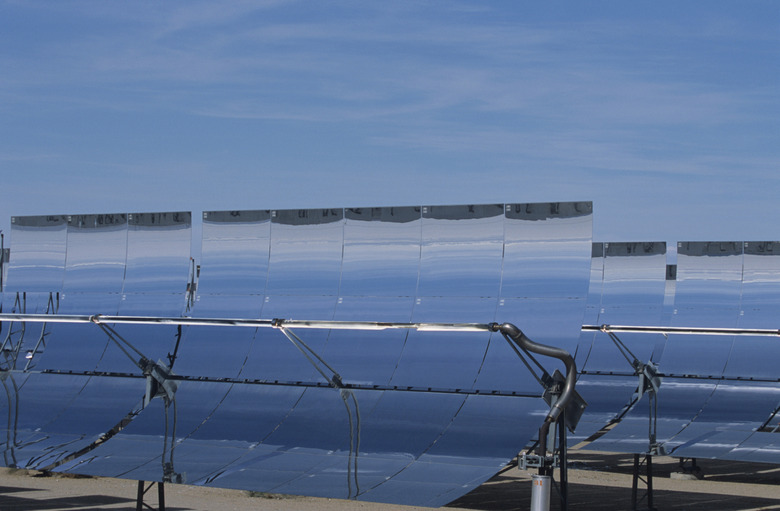3 Examples Of Solar Collectors
Solar collectors are devices that capture the sun's heat to perform tasks, as opposed to photovoltaic panels that use the sun's light. One common use for a solar collector is to provide residential hot water, but they can also provide warm air for home heating or even superheat materials for electricity generation. While many different solar-collector designs exist, they fall into three broad categories.
Flat-Plate Collectors
Flat-Plate Collectors
A flat-plate solar collector represents the simplest type, composed of a rectangular box with a glass cover and a heat-absorbent bottom layer. Sunlight passes through the glass, warming the interior, and a series of pipes or ducts allows water or air to flow through the unit and absorb the ambient heat. Unglazed flat-plate collectors leave out the glass and the sealed box, and simply rely on the sun's heat, warming the pipes themselves. Another variation includes a roof-mounted water tank painted to absorb solar heat. These types of collectors are best suited for warm climates, since even the sealed-box version will allow collected heat to escape readily into cold air.
Evacuated Tube Collectors
Evacuated Tube Collectors
For colder climates or applications that require higher water temperatures, an evacuated tube system offers better insulation. In these collectors, each pipe passes through a sealed glass tube with no air inside. This allows the tube to function like a thermos, minimizing the heat transfer from the interior heated pipe to the outside environment. Evacuated tube collectors may be able to maintain water temperatures of more than 50 degrees Celsius (122 degrees Fahrenheit) above the ambient temperature.
Solar Concentrators
Solar Concentrators
If you need a system that can consistently provide very hot water, a solar concentrator is your best bet. Concentrators use mirrors to reflect and concentrate the sun's energy on water pipes, greatly increasing the temperature of the water within. Since the mirrors in solar concentrators curve to focus the sun's rays, they work best when pointed directly at the sun, and often include tracking systems to follow the sun across the sky for maximum exposure. Solar concentrators are common in large-scale solar-power plants, which contain large fields of trough-shaped mirrors heating a network of water pipes to create steam. This steam drives a turbine, creating electricity.
Solar Towers
Solar Towers
One variation of the solar concentrator design is the solar tower. Instead of a field of concentrators each warming a section of a network of water pipes, a solar tower system uses a field of mirrors all focusing their energy on a single central tower. This raises the temperature at the focus point so high that instead of water, the tower can contain solid matter like salt that becomes molten under the intense heat. Water pipes pass through the structure, absorbing heat from the molten substance, and the steam provided drives a turbine to generate electricity. Molten salt systems have a significant advantage over traditional solar concentrators, because the salt remains hot enough to create steam long after the sun goes down. This can allow a solar plant to create electricity 24 hours a day instead of falling dormant at night.
Cite This Article
MLA
Kazmeyer, Milton. "3 Examples Of Solar Collectors" sciencing.com, https://www.sciencing.com/3-examples-solar-collectors-12321074/. 24 April 2017.
APA
Kazmeyer, Milton. (2017, April 24). 3 Examples Of Solar Collectors. sciencing.com. Retrieved from https://www.sciencing.com/3-examples-solar-collectors-12321074/
Chicago
Kazmeyer, Milton. 3 Examples Of Solar Collectors last modified March 24, 2022. https://www.sciencing.com/3-examples-solar-collectors-12321074/
